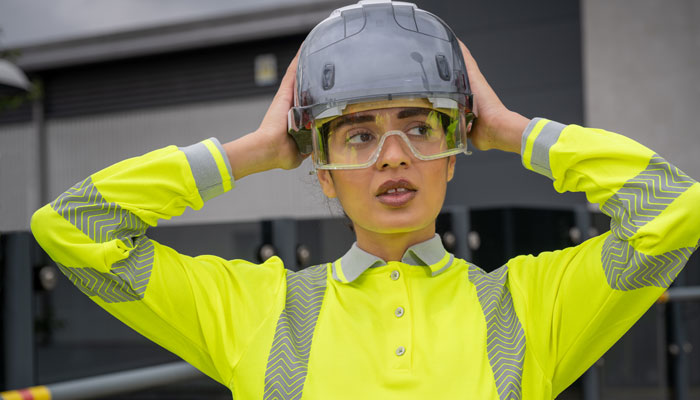Supporting Women in Construction: Addressing Inclusivity in PPE

With more women occupying roles in construction, Hannah Sargent of PULSAR® addresses the need for greater inclusivity in hi-vis workwear and PPE.
According to the Office for National Statistics (ONS), women now make up a higher proportion of the construction workforce than at any time since records began, with female professionals accounting for 15.8% of the industry’s recorded numbers between April and June 2023.
Despite being comparatively lower than other sectors, change can often suggest progress, and many believe the misconceptions surrounding gender-specific roles in industries such as construction, engineering and rail are gradually diminishing. Though elements of that may be true, there’s undoubtedly a number of challenges that still require addressing, with one of those being the allocation of suitable hi-vis protective workwear and PPE.
For labour intensive sectors, protective clothing keeps working professionals safe, secure and compliant. Yet, research from the National Association of Women in Construction for Yorkshire (NAWIC) has highlighted that 59.6% of female professionals do not receive women’s PPE in their construction based role. There’s a glaring issue here, and one that is not unique to the construction industry either. With that in mind, what more can be done to ensure female professionals are equipped in appropriate protective workwear?
Equity over equality
Historically, women have seldom found hi-vis workwear and protective equipment in female fits, with many facing issues on product availability and improper sizing. Too often, gender has gone unnoticed, leaving female employees to make use of the garments provided to them in men’s cuts.
When it comes to fit, there is huge significance in acknowledging gender requirements - especially in safety critical environments. In expecting women to be scaled down versions of their male counterparts, female workforces are inadequately protected in their roles, and are made to feel uncomfortable in the process. Take trousers for example, where a ‘regular-fit’ will often be too tight on a woman’s hips and thighs, whilst simultaneously being too loose around the waist and too long in the legs. Similarly, ill-sized hi-vis coats and jackets can feel dangerously long in the arms, hanging loose over a woman’s hands and making the wearer more susceptible to hazards and injury. When an individual becomes distracted by their workwear, it practically becomes redundant.
Equally, these conditions can also impede the wearer’s ability to perform in their role. Besides restricting movement and heightening risk, poor-fitting workwear can significantly reduce productivity, whereby users must constantly pull up sleeves or trousers before completing a task. In turn, this creates a knock-on effect for women who feel excluded and professionally discredited, and as a result, many skilled professionals may feel forced to leave their role and the industry altogether, impacting a network of projects and occupations. To nurture the confidence of female professionals in construction, employers must start with the equipment.
From the ground up
In an effort to move away from ‘regular fit’ options, protective clothing manufacturers are championing change and are making positive steps in finding suitable resolutions. In doing so, women’s workwear and PPE has made great strides in becoming more obtainable than ever before.
With that said, many end users continue to find a disconnect between their requirements and what is being offered by unreliable ‘womenswear’ products. In seeking out women’s fits, female professionals are still being presented with minimal options and features, as well as cuts that are too short in the crotch or too tight across the chest for example. In some cases, material and fibre selection is also overlooked, with cotton rich products offering little to no flexibility in areas where women need it most.
To amend this, research and testing is key. Conscious design teams are shifting their focus towards the development process, where they can collaborate with end users to conceptualise and create comfortable and functional womenswear products. As decision makers look to balance durability and safety with the needs of female professionals, dedicated garment designers are enlisting trial wearers with a view of positively receiving feedback. By listening to end users throughout each stage of a product’s lifecycle, design teams are better equipped to meet the growing demands associated with inclusive hi-vis workwear and PPE.
As such, if the construction sector is to continue moving in the right direction, employers must also be proactive in their education on inclusive workwear and protective apparel. During product procurement, it’s crucial for decision makers to consider the needs of the entire workforce, regardless of shape, size or gender. By placing emphasis on effective research and garment design, women’s workwear and protective apparel will continue to evolve alongside the proportion of women in this sector. After all, the construction industry needs skilled female professionals. And professionals need appropriate protective clothing.
How PULSAR® is making a difference
PULSAR® works closely with women’s working groups to develop comfortable and functional hi-visibility protective workwear for female professionals. With an experienced female product design team, PULSAR® controls fit development in-house and offers extensive wearer trials to ensure garments are tested in the working environment, with a view of informing the development process and supporting a range of sizes and body shapes. To find out more on PULSAR® and its inclusive Life collection, visit: www.aboutpulsar.com.
Add your comment

- Administration 1
- Catering 1
- Construction 39
- Contracts, Projects, Bids 25
- Energy Management 70
- Engineering, Maintenance 483
- Estates, Property 6
- Facilities Management (main) 258
- Hard Services 75
- Health & Safety 2
- Human Resources 2
- HVAC 178
- Management 3
- M&E 199
- Operations 50
- Security 1
- Soft Services 11
- Training 1
- Waste Management 1
- Workplace 5


